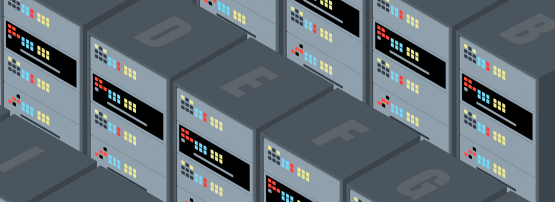
At the ICANN 81 meeting in Istanbul on 10 November 2024, ISC president Jeff Osborn gave a presentation about the DNS Root Server System, in an effort to increase understanding of the Root Server System (RSS) and Root Server Operators (RSOs). The talk was intended for the members of the ICANN Governmental Advisory Committee (GAC), but much of Jeff’s explanation may be of interest to general audiences.
The role and purpose of the DNS
DNS uses human-readable names — commonly called domain names — to find numerical computer addresses. Humans can remember and understand names like www.amazon.com, while computers need IP addresses like 18.239.62.181. The DNS is what tells us that www.amazon.com is at 18.239.62.181. The numbers can and do often change, while the human-readable names stay the same.
Connected devices on the Internet such as computers, phones, printers, refrigerators, and so on, need DNS to be able to find other connected devices. When your smart fridge wants to send an alert to your phone to tell you you’re out of milk, that requires the DNS. But how do all the devices know where to find each other? Each device can ask the DNS questions about domain names, and the answers are IP addresses.
What are the benefits of the DNS? The obvious one is that names are much easier for humans to remember than strings of numbers. But equally important is that the service becomes very portable; the addresses/hardware/platform/location/anything else can be changed, but as long as the name stays the same it will still be findable. The DNS is also a huge, distributed network that’s remarkably easy to use. It is a flexible, delegated database that includes hundreds of millions of directories arranged in what is arguably the world’s largest distributed database.
So that’s DNS in a nutshell, but obviously it’s significantly more complicated in practice.
What are the roles of an address resolver and an authoritative server?
Devices get addresses from address resolvers, of which there are millions in the world. Resolvers can find and read what we might think of as the Internet’s ‘phone books’, which are actually authoritative servers that are held by organizations that each manage a portion of the Internet. Each of these authoritative servers contains the zone content, or address information, for all the domains it controls.
To put it simply, the DNS consists of devices asking questions like ‘What is the number for www.amazon.com?’ and receiving the response ‘The number for www.amazon.com is (at the moment) 18.239.62.181’. These types of questions happen about 500 trillion times per day and are answered in milliseconds by the resolvers.
Normally, the resolvers remember what information they’ve asked for from the authoritative servers, and they hold that information for future queries. This is called ‘caching’. But sometimes, the resolver needs to learn a new number or confirm an old one.
Let’s step through the layers of the process and see how DNS works for the fictitious location ‘www.example.com’, depending on how much information a resolver needs (Figures 1 to 4).
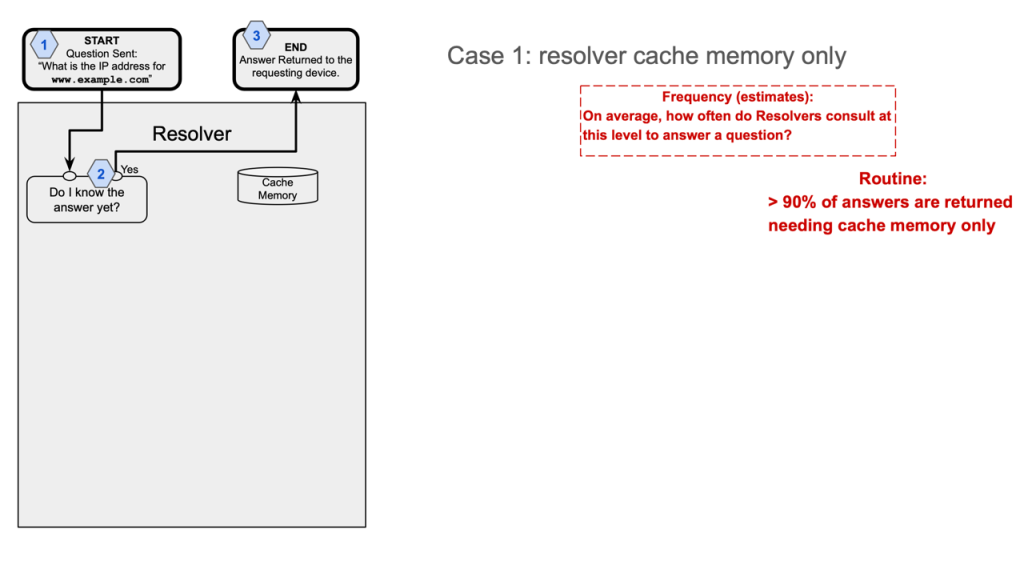
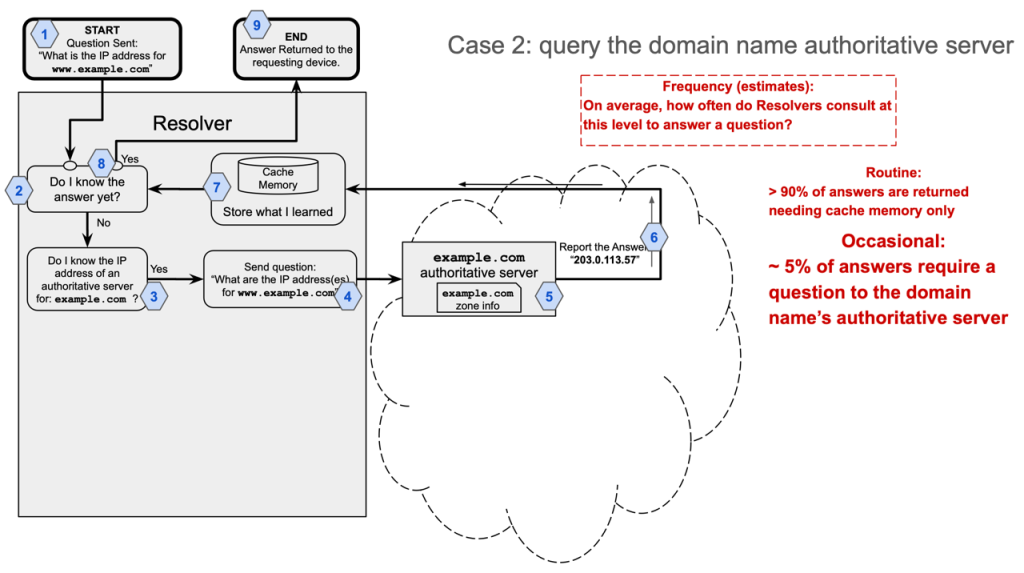
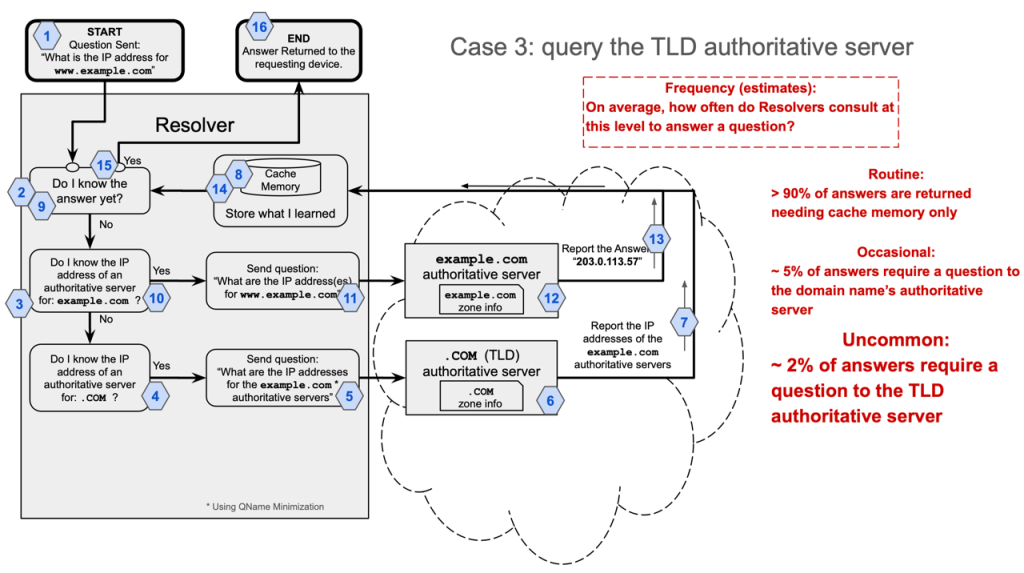
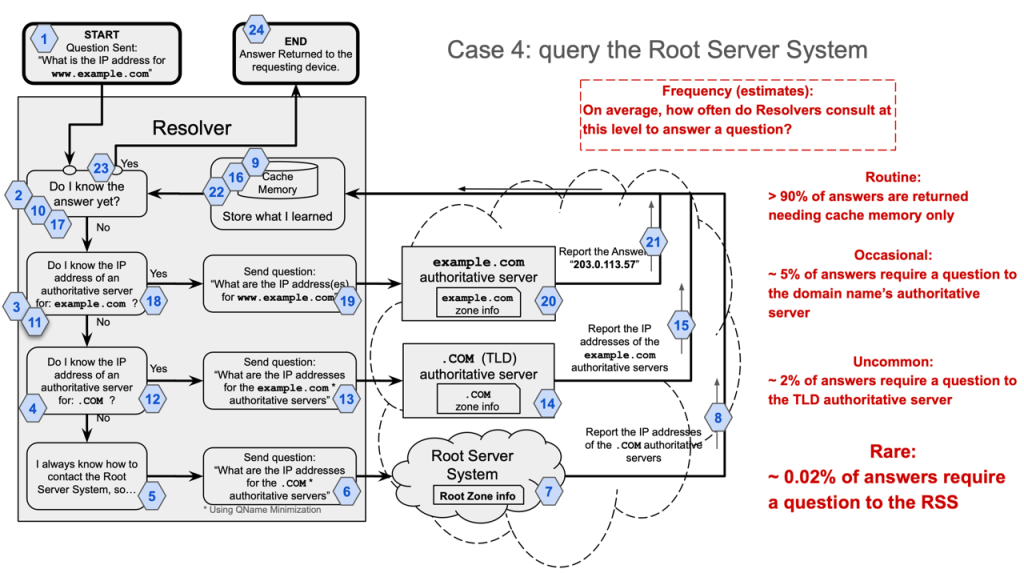
More than 90% of answers fall under Case 1, where the resolver has the final IP address in its cached memory. Approximately 5% of queries fall in Case 2, and approximately 2% fall into Case 3. Only one of every 5,000 to 10,000 queries, or about 0.02% of the total number of IP address requests, requires a question to the RSS.
How, when, and why a resolver consults the RSS
The task of the RSS is to point queries from resolvers to the authoritative servers of all the TLDs on the Internet.
Thinking of the DNS in layers may help clarify it a bit (Table 1).
| DNS layer | Number of unique zones | Typical number of resource addresses | Maintained by |
| Domain name zones | 350,000,000 | Varies Each [www._], [mail._], and so on | The domain name registrant |
| TLD zones | 1,450 | 1,000 – 10,000,000 | The TLD registry |
| Root Zone | 1 | 1,450 TLDs | IANA / RZM |
There are three ‘layers’ of things that a DNS query might ask, working in order from left to right in an Internet address (like www.example.com) — what we call domain names, TLD zones, and the Root Zone.
- There are estimated to be 350,000,000 different domain names on the Internet, like amazon.com, or isc.org, or royal.uk. They are maintained by a variety of domain registrars throughout the world.
- There are only about 1,450 TLDs, like .fr or .edu. Each one may usually have between 1,000 and 10,000,000 domains within it. The TLDs are maintained by different TLD registries that fully control the domains under those TLDs.
- The Root Zone, by comparison, is very small. It is one document, containing a list of the 1,450 TLDs and an address for each one. It is maintained by the Internet Assigned Numbers Authority (IANA) and cryptographically secured by the Root Zone Maintainer (RZM).
To recap:
- A root server holds a copy of the Root Zone.
- The Root Zone holds the addresses of the 1,450 TLDs, such as .com, .nl, .jobs, and so on.
- A TLD’s authoritative server knows the address for all domain names under it, such as all addresses that end in .com (like tiktok.com or amazon.com), all addresses that end in .nl (like google.nl or amsterdam.nl), or all addresses that end in .jobs (like tech.jobs or highpay.jobs).
- A domain name’s authoritative server knows the addresses for the specific servers in its domain, like www.amazon.com or mail.amazon.com or info.amazon.com.
- The resolver on each device finds and returns the answer when the user wants it.
In the millisecond world of a resolver, queries to the RSS are rare.
RSS: What it is and what it isn’t
Let’s look a little more closely at the RSS itself.
1. The RSS provides address information, not content.
The RSS answers one small part of an address question: ‘Can you give me the address of an authoritative server where I can look up the addresses of the TLDs?’ The RSS does NOT offer content, it does not host websites or email or any other content, and it does not transmit or deliver any Internet content.
Takeaway: The RSS does not manage or carry any Internet content.
2. The RSS is not a ‘gatekeeper’ to the Internet.
It answers questions posed by address resolvers, in those rare instances when the address resolvers don’t already have the address answers in their cached memory.
Takeaway: Internet traffic is almost always transmitted without the need to interact with the RSS.
3. The RSS is stable, secure, and resilient.
From a technological standpoint, the RSS consists of more than 1,800 globally distributed server instances, making it massively redundant. Each server instance holds 100% of the Root Zone information, and all these servers feature diverse hardware platforms, operating systems, DNS applications, and data routing.
Takeaway: The RSS has no single point of technological failure.
From an institutional standpoint, the RSS is jointly operated by 12 autonomous RSOs around the globe. Each RSO is independent of the others, yet they continuously collaborate with each other. A force majeure event suffered by one RSO (such as a court injunction) has no operational impact on the others.
Takeaway: The RSS has no single point of institutional failure.

Figure 5 — The root server system consists of 1,921 instances, managed by 12 independent operators. Source: root-servers.org
4. The RSS has operated since the 1980s and has never suffered a service blackout, although many online attackers have tried.
The diversity of the system is its strength.
Takeaway: The RSS has a history of nearly 40 years of successful 24x7x365 operation.
5. RSOs do not decide what appears in the Root Zone. They are simply a reliable, authenticated delivery method.
- A registrant (the domain name holder) decides address information for its own domain and provides their authoritative service address to the TLD registry.
- A TLD registry decides its authoritative server addresses and provides those to IANA.
- IANA authenticates all revisions to TLD authoritative server addresses and provides them to the RZM.
- The RZM cryptographically signs the Root Zone and provides it to the RSOs and the world.
Takeaway: The RSS serves the TLD addresses provided by the TLD, IANA, and RZM.
The RSS underpins the DNS, but actual queries to the RSS in normal Internet operations are extremely rare.
I hope this information has been useful. My full presentation and slides, are available online.
Jeff Osborn is the President of Internet Systems Consortium (ISC), the leading developer of DNS (BIND) and DHCP open source software. ISC operates the F-Root server globally.
The views expressed by the authors of this blog are their own and do not necessarily reflect the views of APNIC. Please note a Code of Conduct applies to this blog.
